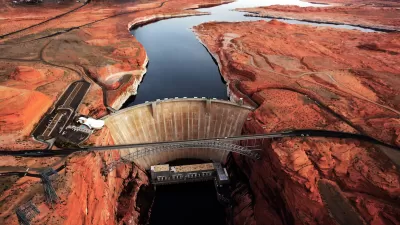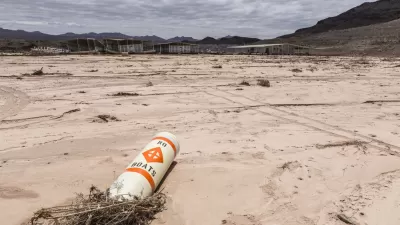Lake Powell levels could dip below the dam’s capacity to generate electricity, cutting off one of the Southwest’s most important power sources.

A piece by Jonathan Thompson highlights the crisis facing Lake Powell, which, as Planetizen has previously amplified, has reached its lowest level since Glen Canyon Dam was first constructed. “In March, Lake Powell’s surface level dropped to within 33 feet of the minimum needed to generate hydropower, for the first time since it was filled in the 1960s. If — or when — it hits that critical point, the Southwest power grid will lose one of its biggest electricity generators, as well as an indispensable backup power source.”
“Over the last few months, federal officials have attempted to stave off the power plant’s obsolescence by increasing releases from upstream dams and by sending less water downstream. But that failed to buoy reservoir levels, so now they have embarked on an effort to install turbines river outlet tubes lower on the dam, which would allow hydroelectricity generation to continue below minimum power pool — for a while.”
At full capacity, Glen Canyon Dam produces 1,300 megawatts of power. “In the 1990s, the dam produced as much as 7,000 gigawatt hours per year, enough to power nearly 600,000 homes. Last year, it was down to just 3,000 gigawatt hours.” Losing the power generated by the dam would increase costs, particularly for tribal nations. “The Navajo Tribal Utility Authority’s yearly power bill could jump by as much as $1.3 million, according to a 2016 consultant’s study, and nine other tribes would also see significant cost increases.”
FULL STORY: Powell’s looming power problem

Alabama: Trump Terminates Settlements for Black Communities Harmed By Raw Sewage
Trump deemed the landmark civil rights agreement “illegal DEI and environmental justice policy.”

Planetizen Federal Action Tracker
A weekly monitor of how Trump’s orders and actions are impacting planners and planning in America.

The 120 Year Old Tiny Home Villages That Sheltered San Francisco’s Earthquake Refugees
More than a century ago, San Francisco mobilized to house thousands of residents displaced by the 1906 earthquake. Could their strategy offer a model for the present?

Opinion: California’s SB 79 Would Improve Housing Affordability and Transit Access
A proposed bill would legalize transit-oriented development statewide.

Record Temperatures Prompt Push for Environmental Justice Bills
Nevada legislators are proposing laws that would mandate heat mitigation measures to protect residents from the impacts of extreme heat.

Downtown Pittsburgh Set to Gain 1,300 New Housing Units
Pittsburgh’s office buildings, many of which date back to the early 20th century, are prime candidates for conversion to housing.
Urban Design for Planners 1: Software Tools
This six-course series explores essential urban design concepts using open source software and equips planners with the tools they need to participate fully in the urban design process.
Planning for Universal Design
Learn the tools for implementing Universal Design in planning regulations.
Clanton & Associates, Inc.
Jessamine County Fiscal Court
Institute for Housing and Urban Development Studies (IHS)
City of Grandview
Harvard GSD Executive Education
Toledo-Lucas County Plan Commissions
Salt Lake City
NYU Wagner Graduate School of Public Service





























